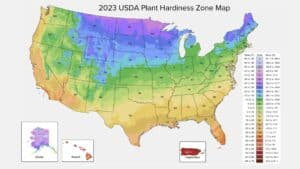
Latest USDA Plant Hardiness Zone Maps Update
The latest USDA Plant Hardiness Zone Maps update released on Nov. 15, 2023 has a 5-degree half zone warmer designation for half the country.
What Zone Am I In Duval County?
Whereas Northeast Florida’s Duval County was previously split between half zones 8b and 9a, the new USDA Hardiness Zone splits Jacksonville between zone 9a West of State Hwy 9A and zone 9B, which extends east to the coast and north to the Southerly point of Cumberland Island in Georgia. The new 8b zone has moved nearly two hundred miles to the north near Macon, Georgia.
“The 2023 map incorporates data from 13,412 weather stations compared to the 7,983 that were used for the 2012 map,” according to the USDA. “When compared to the 2012 map, the 2023 version reveals that about half of the country shifted to the next warmer half zone, and the other half of the country remained in the same half zone. That shift to the next warmer half zone means those areas warmed somewhere in the range of 0-5 degrees Fahrenheit; however, some locations experienced warming in the range of 0-5 degrees Fahrenheit without moving to another half zone.”
The updated map is available at https://planthardiness.ars.usda.gov/
How to use the USDA Plant Hardiness Zone Maps:
The interactive USDA Plant Hardiness Zone maps allow you to enter your zip code to determine your zone. Each half-zone a and b designation represents 5-degree F increments of each zone’s colder and warmer half. These temperatures mean the typical extreme cold temperatures, as determined by the weather stations, that you should compare to the cold hardiness rating on your choice of plants. Note that you can still expect some variability in actual weather conditions and that the USDA does not establish the associated cold hardiness rating applied to plants by growers. Furthermore, gardening retail centers often carry plants that are not rated for the hardiness zone they sell them in based on consumer demand and plant breeder merchandising and as an attempt to push the boundaries and create demand.
How are cold hardiness zones determined?
The USDA Plant Hardiness Zone Map divides the United States into 13 zones based on the average annual minimum extreme temperature experienced in each region. The zones range from 1a (coldest) to 13b (warmest). The USDA considers the average low temperature over a 30-year period to determine the cold hardiness zone for a specific area and updates the zones every ten years. “The 2023 map is based on 30-year averages of the lowest annual winter temperatures at specific locations, is divided into 10-degree Fahrenheit zones and further divided into 5-degree Fahrenheit half-zones,” according to the USDA. Other factors such as elevation, proximity to bodies of water, and microclimates within an area can also influence the particular hardiness zone.
Why is it important to know your cold hardiness zone?
Knowing your cold hardiness zone is important for several reasons:
1. Plant selection: Different plants have different tolerance levels to cold temperatures. Knowing your cold hardiness zone allows you to choose plants well-suited to your climate. This helps ensure that your plants have a better chance of surviving the winter without being damaged or killed by prolonged exposure to freezing temperatures.
2. Winter protection: Understanding your cold hardiness zone helps you determine the level of protection your plants may need during the winter. For example, plants in colder zones may require insulation, such as mulching or covering with protective materials, to prevent frost damage.
3. Planting timing: Your cold hardiness zone also affects when you should plant certain crops or flowers. Some plants need a certain length of time without frost to grow and mature properly. Knowing your zone lets you make informed decisions about the best time to plant for optimal growth and yield.
4. Garden planning: When designing your garden or landscaping, knowing your cold hardiness zone allows you to select various plants that will thrive in your climate. This can help you create a visually pleasing and successful garden environment.
5. Microclimates: Within a specific area, conditions such as heavy tree canopies and wind and temperature blocks created by physical structures contribute to varied climatic conditions compared to the overall zone. Knowing your cold hardiness zone in consideration of any microclimate variations can help you further customize your plant selection and protection strategies.
The latest USDA Plant Hardiness Zone Maps update is beneficial for gardeners, farmers, and landscaping professionals seeking information to better understand which plants are most likely to thrive in specific regions based on their tolerance to cold conditions. By using the USDA Plant Hardiness Zone Map, individuals can choose plants best suited to their local climate and avoid potential damage and loss due to extreme temperatures.
From our office in Atlantic Beach and satellites throughout Northeast Florida, Rockaway Inc proudly serves both commercial and residential landscape design, maintenance, lawn care, irrigation, and outdoor living carpentry client needs in Jacksonville, St Augustine, Atlantic Beach, Neptune Beach, Jacksonville Beach, Ponte Vedra, Nocatee, St. Johns, and Fernandina Beach.
